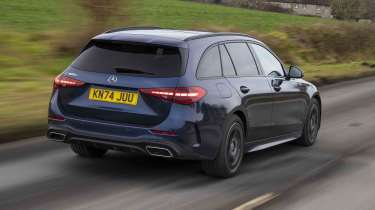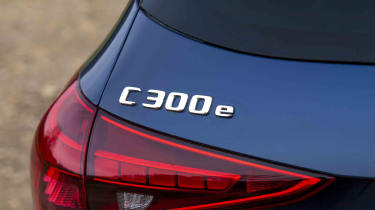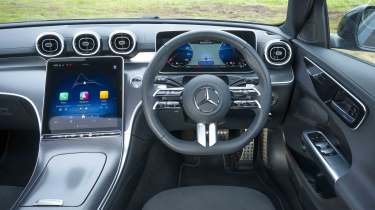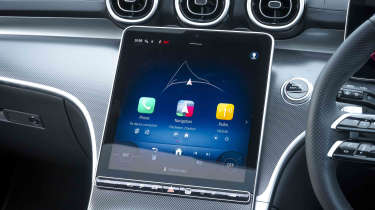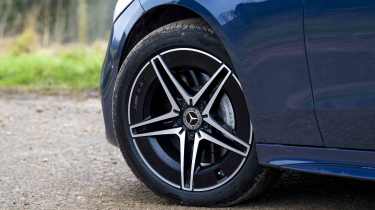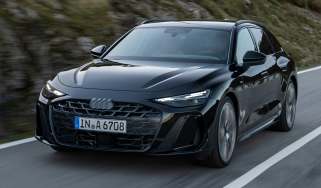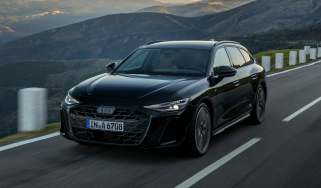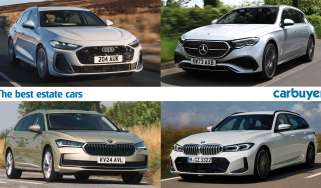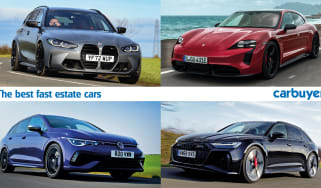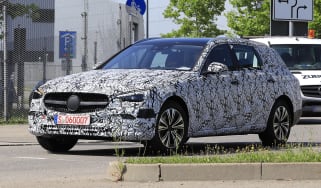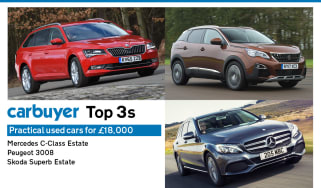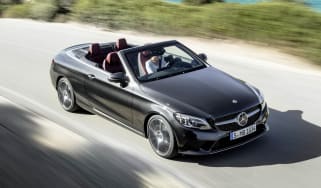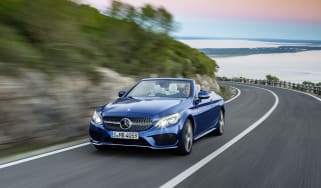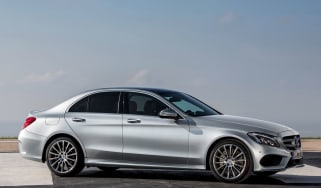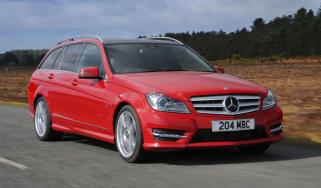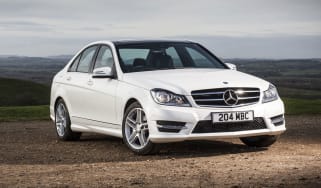Mercedes C-Class Estate review – a classy load-lugger and great PHEV
"The Mercedes C-Class Estate is a comfortable and luxurious way to transport passengers and their luggage"
Pros
- Stylish interior
- Impressive PHEV
- Usable boot
Cons
- C 200 can feel underpowered
- Conservative styling
- PHEV has smaller boot
Verdict – is the Mercedes C-Class Estate a good car?
Suddenly the Mercedes C-Class Estate looks rather traditional. It’s not an SUV for a start – as most cars nowadays seem to be – and it can be had with petrol or diesel engines. These do at least feature mild-hybrid tech to make them more efficient, but the most desirable C-Class Estate is surely the plug-in hybrid. This boasts a 60-plus mile electric range, so many drivers will only need to use petrol for long motorway trips. The Mercedes looks good and has a classy interior, but its interior and boot aren’t quite as spacious as you might expect.
Mercedes C-Class Estate models, specs and alternatives
The Mercedes C-Class Estate is the larger, more practical version of the brand’s mid-size executive rival to the BMW 3 Series and Audi A4, the Mercedes C-Class saloon. It’s been a staple of the lineup since the late 90s, and while it’s a rather traditional-looking product, it’s since evolved in all the right ways to stay modern.
Now every version of the C-Class Estate, like its saloon counterpart, gets some form of electrical assistance, including mild-hybrid technology lower down in the lineup, and plug-in hybrid tech on top-of-the-range models, allowing for up to 68 miles of electric-only range on a charge.
 Best estate cars on sale in 2025
Best estate cars on sale in 2025
This, the sixth-generation, isn't a radical design departure; instead it’s a subtle makeover that brings it into alignment with the E-Class and S-Class. Slim LED headlights and a wide grille take centre stage, and there's a heavily creased bonnet, but the car's flanks are smooth and simple with almost no creases. The Estate's rear lights are wider and everything has been reprofiled, but many onlookers will struggle to tell that it's the new car.
More reviews
Not so inside, where a large portrait central touchscreen gives the game away. The previous C-Class was starting to feel a bit dated inside and this version remedies that with an ultra-modern interior sporting the brand's most up-to-date MBUX software. Quality and luxury are class-leading, and not far removed from what you'll find in the flagship S-Class.
Its rivals are somewhat reduced in numbers, but still include the BMW 3 Series Touring and Audi A5 Avant, while the Volkswagen Passat Estate is also more upmarket than ever. The C-Class Estate starts from around £47,000, which is around £5k more than the BMW and a further few thousand above the Volkswagen.
Four regular engines are available, badged C 200 and C 300 for the petrols and C 220 d or C 300 d for the diesels. The C 200 uses a 201bhp 1.5-litre engine with 48-volt mild-hybrid assistance for a 0-62mph time of 7.5 seconds. With rear-wheel drive and an automatic transmission it's good to drive, offering impressive comfort and composure, but lacks some mid-range power. The C 300 is the most powerful mild-hybrid petrol, with 255bhp from a 2.0-litre engine that gives it a brisker 0-62mp time of six seconds.
The refined and potent diesels are likely to suit long-distance drivers and anyone regularly loading the car up or using it for towing, and the C 300 d is currently the quickest non-AMG C-Class, getting from 0-62mph in 5.8 seconds. Meanwhile, company-car drivers may well be tempted by the C 300 e plug-in hybrid, thanks to its low CO2 emissions and therefore cheap Benefit-in-Kind (BiK) tax.
While interior space has only seen a minor increase, the 490-litre boot is now 30 litres larger than before – and almost on a par with the 500-litre 3 Series Touring. The boot could do with a few more ways to secure cargo but it's a good shape and has switches to easily fold down the seats.
MPG, running costs & CO2
Every C-Class Estate is now electrified, meaning all have some form of electrical assistance giving the engine a helping hand. There's a 1.5-litre petrol in the C 200 and a 2.0-litre petrol in the C 300, returning just over 40mpg. These are best suited to private buyers and business users who drive around 12,000 miles or less each year. Their mild-hybrid hardware stores small amounts of electricity as the car slows down, then uses it to power the car's systems and provide a small boost under acceleration.
Higher mileage drivers are still likely to be drawn to the C 220 d and C 300 d 2.0-litre diesels, and for good reason. As well as being punchy and refined, the C 220 d can return up to 60.1mpg, depending on the trim level and options fitted, and provide a good range between refills.
The C 300 d isn’t far behind, returning up to 53.3mpg according to official testing. We found we could easily hit an indicated 59mpg during a mixture of motorway and town driving, which proves there’s still a reason to pick a diesel C-Class even as they slip down sales charts.
The plug-in hybrid C 300 e is perhaps the most desirable version of all, however, thanks to its claimed 65 to 68-mile electric range. This gave it a big advantage over the 37-mile range of the 330e Touring, however, the facelifted BMW 3 Series will get a more competitive 60-plus mile range. A larger 25.4kWh battery (up from 13.5kWh) is the main reason for the Mercedes’ improvement. With low 13g/km CO2 emissions, the C 300 e is in a low BiK band, however, plug-in hybrids do now have to pay the London Congestion Charge.
Engines, drive & performance
While the BMW 3 Series Touring has long been the pick of the executive models for keen drivers, the C-Class Estate has focused more on relaxation and comfort. That's still the case for the latest model but the gap is now closer than ever.
There's a natural feel to the steering, which is also quite direct, and if you choose Sport mode the C-Class stays almost flat while it's tackling corners. There’s also the option of rear-wheel steering to make the C-Class feel even more agile. The soft suspension makes itself known in the C 300 d, which lifts its nose slightly if you accelerate hard, while the brakes are strong and even provide decent feel through the pedal.
We've tried the C 200 with its 1.5-litre four-cylinder petrol engine and 48-volt mild-hybrid technology, but there’s also a C 300 with the 2.0-litre engine and 255bhp if you want more power from a petrol, aside from the AMG version. It’s worth noting that the C 300 d diesel is actually slightly more powerful than the C 300, and does the 0-62mph quicker than the C 300’s six-second figure as a result.
Thanks to its 201bhp, rear-wheel drive and nine-speed automatic transmission, the C 200 can get from 0-62mph in a respectable 7.5 seconds. This gearbox – which is standard across the range – is excellent, providing smooth changes, and the C 200 is quiet while cruising on the motorway.
On more challenging roads, the C 200 is less impressive, with less mid-range acceleration than you may want. This can cause the gearbox to shift down, increasing the revs and slightly coarse sound of the engine as it works hard. This could become wearing, especially if carrying a full load of passengers and luggage, especially since you can buy the C 220 d, which has more punch and is more refined.
The C 300 d is currently the fastest C-Class, because while its 261bhp is less than the 309bhp of the plug-in hybrid C 300 e, it’s also significantly lighter. Acceleration from 0-62mph takes 5.8 seconds and its top speed is limited to 155mph. It also puts the C 300 d in an area with no direct rivals – the BMW 320d has been discontinued for the 2024 facelift. The Audi A4 Avant has now been replaced by the Audi A5 Avant, which does get a diesel, albeit with just 201bhp. On the road, the 300 d certainly feels quick enough in almost every situation, and its EQ Boost mild-hybrid assistance helps it get off the line quickly.
We’ve also driven the C 300 e, and in its electric-only mode it’s quiet and can easily keep up with traffic around town, and even up to the national speed limit. With both the electric motor and petrol engine working, there’s an impressive 309bhp on tap, and power is juggled pretty smoothly. It does feel pretty quick when you put your foot down, too, but the petrol engine can sound a bit coarse at times. Despite its superior power compared with the standard petrol and diesel models, don’t expect it to feel particularly sporty, given its added weight.
Interior & comfort
If the C-Class driving experience will appeal to some buyers more than others, most will agree the interior is pretty impressive in most respects. The quality of some of the most important materials and finishes is up there with the best in class, and not only are the seats comfortable, they also offer lots of adjustment for different body shapes. It’s not perfect, however, with some areas trimmed in plastic that feels a bit hard and scratchy.
Fibre-optic ambient lighting gives the C-Class a truly special feel at night and neat touches like a column-mounted gear selector stalk help the Mercedes compete with electric models for storage space in the centre console. It has the feel of a shrunken S-Class inside, and Mercedes has moved away from excessive use of piano-black trim, which tends to be a fingerprint magnet.
The 12.3-inch instrument display and optional 11.9-inch portrait central touchscreen are both sharp and responsive, removing almost all the physical buttons found in older models. If you'd prefer not to interact with the screen while on the move, the “Hey Mercedes” voice assistant has also been given an upgrade, so it can respond to spoken commands more quickly and accurately. It works pretty well, but we still find the BMW iDrive setup easier to navigate. We need to spend more time with the 'augmented reality' setup before giving it the thumbs up, however, as we found the overlay camera view could temporarily obscure other information.
Importantly, the C-Class has excellent refinement and ability to soak up bumps, so it feels pretty relaxed on British roads. It is low-slung though, with noticeable scrapes from plastic trim as you navigate steep speed bumps.
Practicality & boot space
With the explosion of SUVs – including from Mercedes itself – the C-Class Estate has to work even harder to impress buyers with the space it has to offer. Its wheelbase (the gap between its front and rear wheels) has been stretched slightly, but the rear seats still feel short on knee room for anyone around six feet tall, while headroom isn't too bad.
The boot has grown by 30 litres to 490 litres behind the rear seats, increasing to 1,510 litres with them stowed flat. It's a necessary improvement, as the Audi A5 Avant and BMW 3 Series Touring offer 476 and 500 litres respectively. Largely because of its extra height, the Mercedes GLC does offer slightly more room, with up to 550 litres of space. There are some hooks and a 12-volt socket for accessories but clever ways to help secure loads would improve things further.
Because of its battery pack, the plug-in hybrid doesn't offer quite as much boot space but it has been improved over the outgoing version. There's now 360 litres of room behind the seats (a 45-litre increase), increasing to 1,375 litres with them folded down.
Mercedes' clearly expects the Estate to be popular with owners who want to tow because it's available with an optional 'trailer manoeuvring assistant'. This can semi-autonomously reverse the car at a selectable angle of up to 90 degrees, making it less stressful to reverse a trailer.
Every version of the C-Class from the C 200 to the C 300 d and plug-in hybrid, all have the same maximum towing capacity of 1,800kg for a braked trailer, or 750kg unbraked.
Reliability & safety
It's a bit of a mixed story here because while Mercedes has no problem at all building safe cars, loaded with cutting-edge collision avoidance technology, reliability hasn't been first-rate in recent years.
The latest C-Class has been crash-tested by Euro NCAP and awarded a five-star result, with 93% in the Adult Occupant category. Advances to Mercedes' Driving Assistance Package mean the C-Class can help the driver stay in the middle of the lane on the motorway, taking some of the stress out of long-distance driving. Features like an expansive head-up display also help provide the driver with more information, without them needing to look away from the road ahead.
While the reliability of the latest C-Class Estate won't be known for several years, its predecessor was ranked 74th in our 2019 Driver Power survey of owners and didn't appear thereafter. As a manufacturer, Mercedes finished 25th out of 32 brands in 2024, with 26.3% of respondents reporting one or more faults within the first year of ownership. It’s a disappointing result, placing the brand behind Audi (22nd), BMW (14th), Lexus (12th) and Jaguar (ninth).
The latest model is an evolution of the old C-Class, so we're hoping Mercedes will have been able to remedy any weak spots in its design, improving reliability for new buyers. The ability to update more of the car's software with over-the-air updates may also be able to remedy some issues without an inconvenient trip to the dealership.
Which Is Best?
Cheapest
- NameC43 [421] 4Matic Premium 5dr 9G-Tronic
- Gearbox typeSemi-auto
- RRP£70,640
Most Economical
- NameC63 S e 4Matic+ Night Ed Premium + 5dr MCT
- Gearbox typeSemi-auto
- RRP£99,975
Fastest
- NameC63 S e 4Matic+ Night Ed Premium + 5dr MCT
- Gearbox typeSemi-auto
- RRP£99,975

